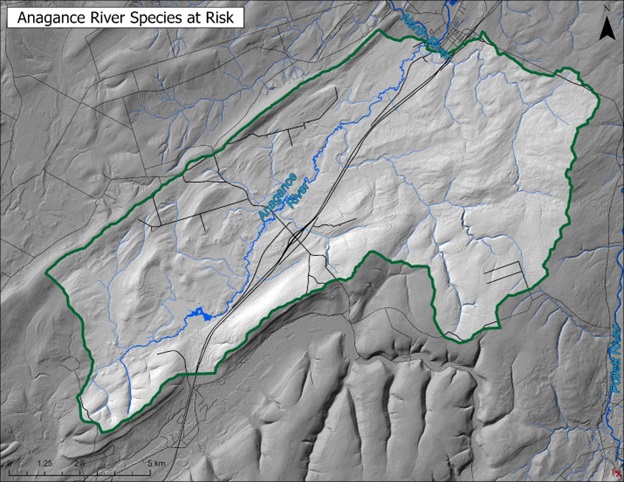Third Level Assessment – Aquatic and Riparian Habitat Assessment
Wildlife
Several species of wildlife that warrant specific attention either are or have been historically found within the Anagance River watershed: Atlantic salmon, American eels, and wood turtles. Guidelines for projects in areas with these are in the Appendix.
Atlantic salmon (Salmo salar) Inner Bay of Fundy (iBoF) populations were listed as endangered under the Species at Risk Act in 2003 (DFO 2010; SARA Registry 2013a), and the species is considered extirpated from the Petitcodiac River system, except for those introduced in stocking programs (AMEC 2005). The decline in iBoF salmon is a marked contrast to the abundance described by early settlers (Dunfield 1991). Though numbers had been decreasing for some time (Elson 1962) construction of the causeway between Moncton and Riverview in 1968 complicated fish passage and extirpated the species from a river system that despite being 1 of 50 iBoF rivers, represented 20% of the total iBoF population (Locke, et al. 2003).
American eels (Anguilla rostrata) were designated as “Special Concern” by COSEWIC in 2006 (COSEWIC 2006). Their status was re-examined and raised to “Threatened” in May 2012 (COSEWIC 2014). This species is being considered for listing under the federal Species at Risk Act, but currently it has no status (SARA Registry 2013b).
Wood turtles (Glyptemys insculpta) were designated as “Special Concern” by COSEWIC in 1996 which was raised to “Threatened” in 2007 (COSEWIC 2007; COSEWIC 2011). This species is listed as “threatened” under the Species at Risk Act (SARA Registry 2012).

As indicated in Figure 8, Fort Folly Habitat Recovery has no data on the distribution of any of these Species at Risk within the Anagance River watershed. This is due to a lack of recent field work within this watershed, rather than knowledge to suggest that they are absent. Of the three species considered here, it is reasonable to assume that eels are present, salmon are likely absent, and turtles may or may not be present.
American eels were documented on both Holmes and Hayward Brook between 1994 and 1996 during work done there by Université de Moncton for the Fundy Model Forest (Chiasson 1996). That isn’t surprising, as unlike salmon, eels were not excluded by the Moncton to Riverview Causeway downstream on the Petitcodiac. In fact, while the causeway gates were closed eels were found to be the most abundant resident species upstream of the headpond (Flanagan 2001), and one of the dominant species within the headpond (Locke et al 2000). While there is no recent data available on eel numbers within the Anagance River watershed, unlike salmon there is no reason to think that eels would have disappeared over the last 28 years. Arguably this indicates that there might be value in undertaking work within the Anagance River at some point to address this knowledge gap. The same can be said of wood turtles.












